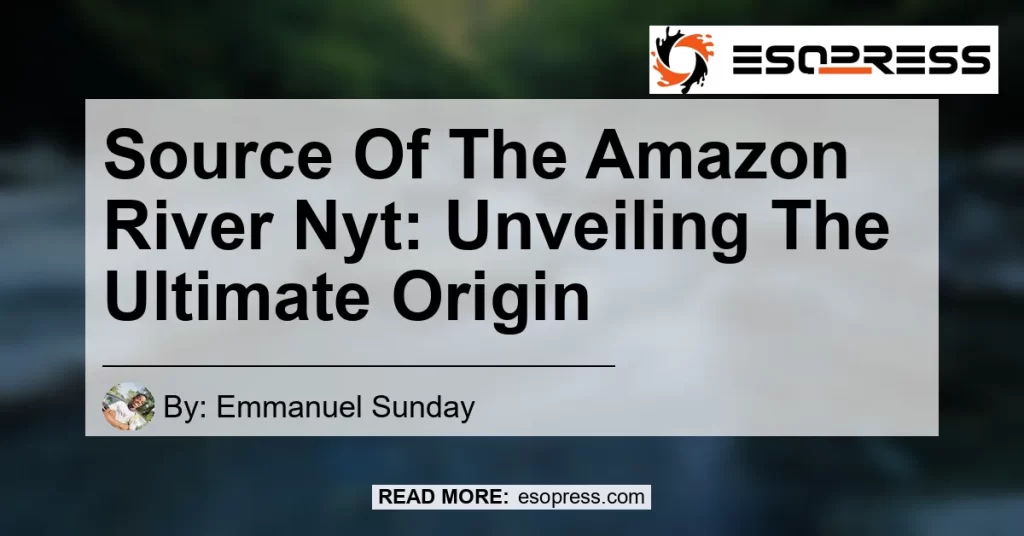

The Amazon River is one of the most iconic and majestic rivers in the world. It stretches over 6,400 kilometers and is known for its sheer volume of water and rich biodiversity. But have you ever wondered where this mighty river originates from? In this article, we will delve into the source of the Amazon River and uncover its ultimate origin.
Contents
What is the source of the Amazon River?
The source of the Amazon River is a point in the Andes Mountains known as Nevado Mismi. Located in the Arequipa region of Peru, Nevado Mismi is a snow-capped peak that reaches an elevation of 5,597 meters. It is at this point that the Apurímac River, one of the main tributaries of the Amazon, begins its journey.
How does the Apurímac River become the Amazon River?
The Apurímac River, originating from Nevado Mismi, flows westward through the Andes Mountains. As it continues its course, it receives water from various tributaries, growing in size and strength. Eventually, the Apurímac River merges with the Mantaro River, forming the Ene River.
The Ene River, in turn, joins forces with the Tambo River, creating the Ucayali River. The Ucayali River continues its relentless journey, gathering even more water from other tributaries, until it eventually meets the Marañón River.
Finally, the Marañón River and the Ucayali River merge near the city of Nauta in Peru, forming what is officially recognized as the Amazon River. From this point onward, the Amazon River meanders through the vast Amazon Rainforest, soaking up water from countless tributaries and sustains the remarkable ecosystem of this unique region.
Why is Peru the source of the Amazon River?
Peru is considered the source of the Amazon River because it is where the Apurímac River, the earliest traceable tributary of the Amazon, originates. The Apurímac River’s headwaters begin at Nevado Mismi, a mountain peak in Peru’s Andes Mountains.
The choice of Peru as the source is significant not only because of its geographical location but also because the Amazon Rainforest spans across several countries in South America, including Brazil, Colombia, and Ecuador. Peru’s recognition as the source of the Amazon River highlights the country’s vital role in the ecosystem and reinforces its commitment to protecting this natural wonder.
Exploring the Amazon Rainforest
The Amazon Rainforest, nourished by the Amazon River, is the largest tropical rainforest in the world. It spans across several countries and covers approximately 5.5 million square kilometers. The rainforest is home to an incredible array of plant and animal species, many of which are found nowhere else on Earth.
Exploring the Amazon Rainforest is a breathtaking experience, allowing travelers to witness the beauty and diversity of this unique ecosystem firsthand. From vibrant parrots and playful monkeys to elusive jaguars and giant river otters, the rainforest teems with life at every turn.
For those seeking adventure, there are various ways to explore the Amazon Rainforest. Guided tours offer the opportunity to venture deep into the jungle, navigate its waterways in traditional canoes, and learn from local indigenous communities about their rich cultural heritage and sustainable practices.
Protection and Preservation
Given the environmental significance of the Amazon Rainforest and its integral connection to the source of the Amazon River, efforts to protect and preserve this invaluable ecosystem are of utmost importance. The conservation of the rainforest is essential not only for the preservation of its biodiversity but also for the global climate.
Deforestation poses a significant threat to the Amazon Rainforest, as it disrupts the delicate balance of the ecosystem and contributes to climate change. Logging, mining, and agricultural practices, such as the expansion of soybean plantations and cattle ranching, are among the main drivers of deforestation in the region.
Organizations and initiatives focused on conservation and sustainability, both on a local and global scale, play a crucial role in protecting the Amazon Rainforest. Their efforts involve promoting sustainable land use practices, supporting local communities, and advocating for stricter environmental regulations.
Conclusion
In conclusion, the source of the Amazon River can be traced back to Nevado Mismi, a mountain peak located in Peru’s Andes Mountains. From there, the Apurímac River begins its journey, eventually merging with other tributaries to form the Amazon River.
The Amazon River, originating from Peru, flows through the vast expanse of the Amazon Rainforest, sustaining a remarkable ecosystem of unparalleled biodiversity. Exploring the Amazon Rainforest is a captivating adventure that allows visitors to witness the beauty of this unique environment firsthand.
To ensure the protection and preservation of the Amazon Rainforest and the source of the Amazon River, it is crucial to support initiatives focused on conservation and sustainability. By doing so, we can safeguard this invaluable natural wonder for future generations to come.
Recommended Product: Sony α7 III Mirrorless Camera








